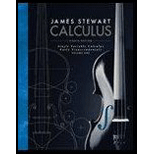
The speed of sound traveling through ocean water is a function of temperature, salinity, and pressure. It has been modeled by the function
C = 1449.2 + 4.6T − 0.055T2 + 0.00029T3 + (1.34 − 0.01T)(S − 35) + 0.016D
where C is the speed of sound (in meters per second), T is the temperature (in degrees Celsius), S is the salinity (the concentration of salts in parts per thousand, which means the number of grams of dissolved solids per 1000 g of water), and D is the depth below the ocean surface (in meters). Compute ∂C/∂T, ∂C/∂S, and ∂C/∂D when T = 10°C, S = 35 parts per thousand, and D = 100 m. Explain the physical significance of these partial derivatives.
Trending nowThis is a popular solution!

Chapter 14 Solutions
James Stewart Calculus for MAT 127/128/229 8th edition
- Find area of the secarrow_forwardi need help pleasearrow_forwardQuestion 4 Find an equation of (a) The plane through the point (2, 0, 1) and perpendicular to the line x = y=2t, z=3+4t. 3t, (b) The plane through the point (3, −2, 8) and parallel to the plane z = x+y. (c) The plane that contains the line x = parallel to the plane 5x + 2y + z = 1. 1+t, y2t, z = 43t and is (d) The plane that passes through the point (1,2,3) and contains the line x = 3t, y=1+t, and z = 2 – t. (e) The plane that contains the lines L₁ : x = 1 + t, y = 1 − t, z = = L2 x 2s, y = s, z = 2. 2t andarrow_forward
- can you explain why the correct answer is Aarrow_forwardSee image for questionarrow_forwardFor this question, refer to the a1q4.py Python code that follows the assignment, as well as the dataprovided after the assignment.(a) Modify the code presented to plot the data from the two separate sets of information(from each region).(b) For each population of squirbos, let ` be the length of their front claws and s the mass ofthe skull. Determine for what value of m the s is isometric to `m. Justify it with your log − log plotsfrom (a) and suitable sketched lines.(c) What do you notice about the correlus striatus on your plot?(d) What historically might explain their situation?arrow_forward
 College Algebra (MindTap Course List)AlgebraISBN:9781305652231Author:R. David Gustafson, Jeff HughesPublisher:Cengage Learning
College Algebra (MindTap Course List)AlgebraISBN:9781305652231Author:R. David Gustafson, Jeff HughesPublisher:Cengage Learning
 Algebra: Structure And Method, Book 1AlgebraISBN:9780395977224Author:Richard G. Brown, Mary P. Dolciani, Robert H. Sorgenfrey, William L. ColePublisher:McDougal Littell
Algebra: Structure And Method, Book 1AlgebraISBN:9780395977224Author:Richard G. Brown, Mary P. Dolciani, Robert H. Sorgenfrey, William L. ColePublisher:McDougal Littell- Algebra & Trigonometry with Analytic GeometryAlgebraISBN:9781133382119Author:SwokowskiPublisher:Cengage

 Algebra and Trigonometry (MindTap Course List)AlgebraISBN:9781305071742Author:James Stewart, Lothar Redlin, Saleem WatsonPublisher:Cengage Learning
Algebra and Trigonometry (MindTap Course List)AlgebraISBN:9781305071742Author:James Stewart, Lothar Redlin, Saleem WatsonPublisher:Cengage Learning





